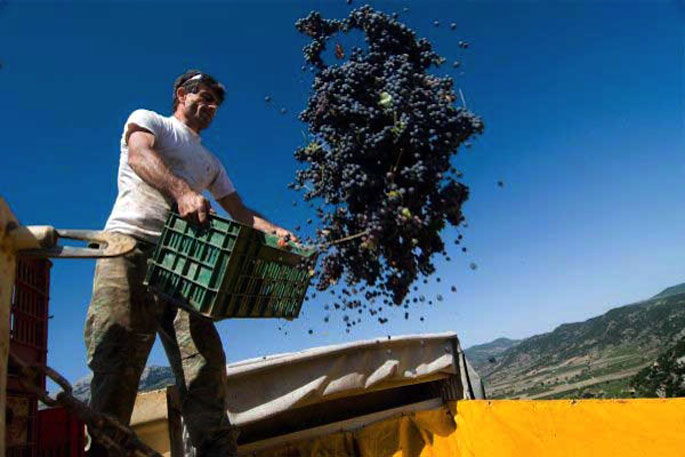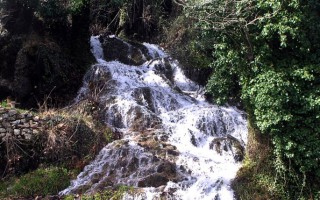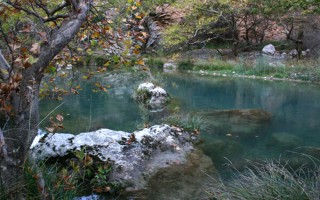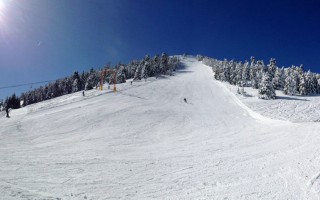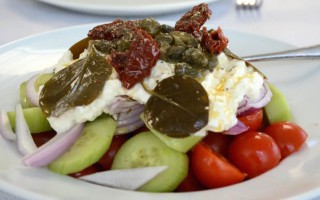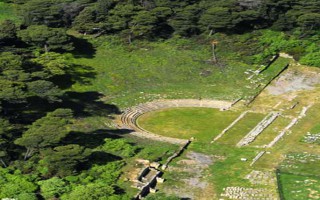The Peloponnese undeniably holds one of the leading positions in terms of wine production in Greece. It’s no coincidence nor a surprise that many of the most domestically and internationally popular wine varieties have their origins in the Peloponnese (the island of Pelops or ampeloessa, according to Homer), since this geographical district has a production of approximately 1,208 labels and a total vine area that covers 29.1% of the Greek wine map. The Wine Producers Association of the Peloponnese, which is based in Tripolis, had the idea of creating the Wine Routes, in order to promote wine tourism, a sector of substantial importance for Greece.
 Arcadia has been famous for the quality of its wine since ancient times. According to Theophrastos, “men lost their minds when they drank it and women got pregnant”. So intoxicating was this wine, that it was also popular among the Gods. Pan, for example, the God of vegetation and fertility, who was known for his womanizing behaviour, as well as Dionysos, the God of wine, who was worshiped through rituals and celebrations of ecstatic inebriation, had Arcadian wine at the top of their preferences.
Arcadia has been famous for the quality of its wine since ancient times. According to Theophrastos, “men lost their minds when they drank it and women got pregnant”. So intoxicating was this wine, that it was also popular among the Gods. Pan, for example, the God of vegetation and fertility, who was known for his womanizing behaviour, as well as Dionysos, the God of wine, who was worshiped through rituals and celebrations of ecstatic inebriation, had Arcadian wine at the top of their preferences.
Even nowadays, Arcadia continues to be an important wine-making centre. One of the most famous vineyards in the country extends across the Mantineian Plateau, where, over a total area of 7,000 square metres, the particularly popular variety, Moschofilero – one of the most aromatic Greek wines – is cultivated. This area has been established since 1971 as a zone of the Mantineia PDO, a region that produces wine with a designation of origin of superior quality. During our tour of the Arcadia Wine Routes we will pass through various places where we will have the chance not only to taste the delectable varieties, but also to admire the unique architecture of the buildings where the wine is produced.
 The first stop is the villages of the municipality of Korythio, which boasts around 5,000 square metres of vineyards. From the old Tripolis – Argos national highway, we head to Steno, which is a village with interesting historical sites. The Church of the Assumption of the Blessed Virgin Mary, which was built in 1847, stands at its centre, while on a nearby hill we see the windmill of Bakopoulos, which dates back to 1850. At the beginning of the 1980s, the team of the Ephor of Antiquities, Dr. T. Spyropoulos, brought to light six thermo-metallurgical kilns from the prehistoric and the late roman years (2500 BC – 500 AD). After the village of Steno we arrive at Agiorgitika, where they also discovered a kiln from prehistoric times, which was the biggest ever revealed. After Agiorgitika, we arrive at the historic Mouchli, where one of the most important castle states of the time held power. The castle of Mouchli was established in 1296 by General Andronikos Asan. It was surrounded by a triple wall, and inside they built the church of the Blessed Virgin Mary Mouchliotissa or the Blessed Virgin Mary of Mouchli, remnants of which still exist. In 1460, the castle was destroyed by the Turks and its residents moved to Constantinople. However, for about a century and a half, it was one of the biggest and most important castles in the Peloponnese. Our tour continues to Partheni. Just before the entrance to the village, we will see three windmills –those of Pantelis, Rasiarmos and Gyftogiannis- while in the village we cannot miss the imposing church of Agios Georgios. Further on, we will see a beautiful lush grove, where the chapel of Agia Kyriaki has been located since 1891. In Partheni we will also have the chance to visit the Folk Art Museum, which is housed in the old elementary school and has exhibits from the wider area. Our next stop is Neochori, which has a lovely main square and a fertile valley where they mainly cultivate potatoes. To the north of the village we will stumble upon the Church of the Assumption of the Blessed Virgin Mary, which -according to an inscription- was established in 1696. At a close distance from Neochori we will see the Monastery of Agios Nikolaos of Varsoi, at an altitude of 1,100 metres, which was built around the 11th century and had a brilliant history up until 1460 when its decadence started. Today, important heirlooms are kept in this monastery, as well as the sacred relics of the martyr Dimitrios, and part of the relics of martyr Pavlos
The first stop is the villages of the municipality of Korythio, which boasts around 5,000 square metres of vineyards. From the old Tripolis – Argos national highway, we head to Steno, which is a village with interesting historical sites. The Church of the Assumption of the Blessed Virgin Mary, which was built in 1847, stands at its centre, while on a nearby hill we see the windmill of Bakopoulos, which dates back to 1850. At the beginning of the 1980s, the team of the Ephor of Antiquities, Dr. T. Spyropoulos, brought to light six thermo-metallurgical kilns from the prehistoric and the late roman years (2500 BC – 500 AD). After the village of Steno we arrive at Agiorgitika, where they also discovered a kiln from prehistoric times, which was the biggest ever revealed. After Agiorgitika, we arrive at the historic Mouchli, where one of the most important castle states of the time held power. The castle of Mouchli was established in 1296 by General Andronikos Asan. It was surrounded by a triple wall, and inside they built the church of the Blessed Virgin Mary Mouchliotissa or the Blessed Virgin Mary of Mouchli, remnants of which still exist. In 1460, the castle was destroyed by the Turks and its residents moved to Constantinople. However, for about a century and a half, it was one of the biggest and most important castles in the Peloponnese. Our tour continues to Partheni. Just before the entrance to the village, we will see three windmills –those of Pantelis, Rasiarmos and Gyftogiannis- while in the village we cannot miss the imposing church of Agios Georgios. Further on, we will see a beautiful lush grove, where the chapel of Agia Kyriaki has been located since 1891. In Partheni we will also have the chance to visit the Folk Art Museum, which is housed in the old elementary school and has exhibits from the wider area. Our next stop is Neochori, which has a lovely main square and a fertile valley where they mainly cultivate potatoes. To the north of the village we will stumble upon the Church of the Assumption of the Blessed Virgin Mary, which -according to an inscription- was established in 1696. At a close distance from Neochori we will see the Monastery of Agios Nikolaos of Varsoi, at an altitude of 1,100 metres, which was built around the 11th century and had a brilliant history up until 1460 when its decadence started. Today, important heirlooms are kept in this monastery, as well as the sacred relics of the martyr Dimitrios, and part of the relics of martyr Pavlos
We then make a visit to the biggest vineyard in Mantineia, known for the production of exceptional and delectable wines, which lies ahead after the village of Zevgolatio. The first stop here is Milia, with its important archaeological remnants. We will see the ruins of a temple dedicated to Ippios Posidon, which was built by Trofonios and Agamidis – famous architects from Viotia. Dr. Spyropoulos revealed an impressive building in a nearby spot, which he identified as the tomb of Epaminondas, the great General and politician from Thiva. A little further on, we see the hill of Gortsouli, around which there are numerous archaeological ruins from the early Helladic and the Hellenistic era. Then we visit Artemision, a beautiful village with impressive stone houses and a scenic bridge which dates back to 1890. Our next stop is Pikerni, with the church of Agios Nikolaos, around which Klimis Gkonopoulos built the homonymous monastery in 1822, as well as the remnants of an ancient castle. The village of Sagka has a spectacular view to the mountains of Mainalo and Lyrkeio. From here, you will see the lovely church of Agioi Theodoroi, with its amazing bell tower, which was built by Tinian craftsmen in 1892, as well as the double-arched bridge of Mpouselitza. The municipality of Mantineia is based in Nestani, where we will see remnants of the walls of the ancient acropolis, the Church of the Annunciation of the Blessed Virgin Mary, as well as many mansions and watermills. We will see, the Monastery of the Blessed Virgin Mary of Gorgoepikoou, which was built around 1080 AD by the Emperor Alexius Comnenus. This monastery houses the miraculous icon of the Virgin Mary, which is believed to be the work of Lucas the Evangelist. After the village of Kapsia, where one of the most notable caves in Greece is located, we make our last stop to the scenic village of Simiades with the Chapel of Agios Prokopios and the archaeological ruins, evidence of past inhabitation.
Merely few of the winery-estates you can visit are the following: Mantineia Winery in Zevgolatio, P. Kalogeropoulos & Co. Winery, also in Zevgolatio, Spyropoulos Estate in Mantineia, Kalogri Estate in Kapsia, Bosinakis Winery in Steno, Boutaris Winery outside of Tripolis, Troupis Winery in Fteri Milias, Boutaris Winery in Milia, Papageorgiou Winery in Artemisio, and many more.
Source: www.mythicalpeloponnese.gr

